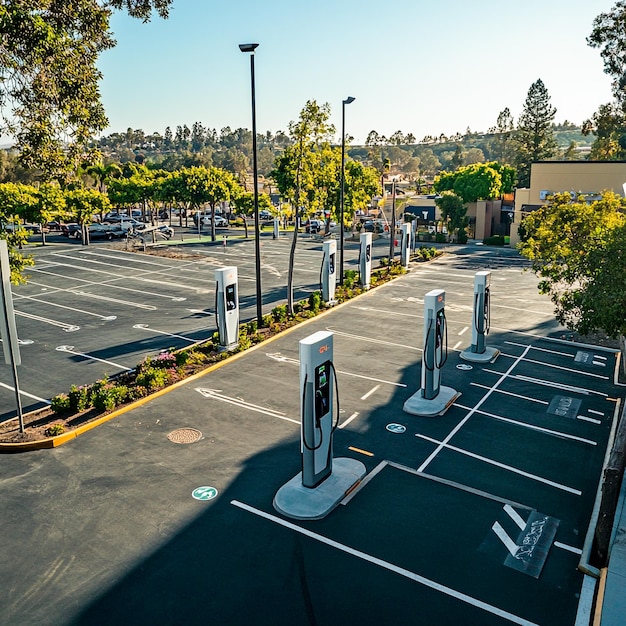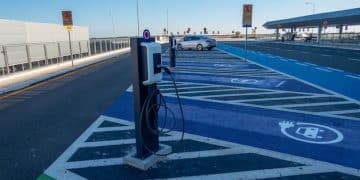Electric Vehicle Charging: Are We on Track for 2030 Goals?

The expansion of electric vehicle charging infrastructure is crucial for meeting the projected EV adoption goals by 2030, but significant challenges remain in terms of investment, technology standardization, and equitable access.
The future of transportation is undeniably electric, with projections indicating a significant surge in electric vehicle (EV) adoption by 2030. But are we truly prepared for this electric revolution? The answer hinges on a critical component: the electric vehicle charging infrastructure: are we on track to meet 2030 goals?.
The Current State of EV Charging Infrastructure in the US
Currently, the US electric vehicle charging infrastructure is a patchwork of public and private networks, each with its strengths and weaknesses. While the number of charging stations has been steadily increasing, the pace may not be sufficient to meet the demands of a rapidly growing EV market.
The availability of charging stations varies significantly across different states and regions. Urban areas generally have better coverage than rural areas, and some states have made more significant investments in charging infrastructure than others.
Types of Charging Stations
Understanding the different types of charging stations is crucial for assessing the current infrastructure landscape. Charging stations are typically categorized into three levels:
- Level 1 Charging: Uses a standard 120V household outlet, offering the slowest charging speed (adding about 4 miles of range per hour).
- Level 2 Charging: Uses a 240V outlet, providing a much faster charging speed (adding about 25 miles of range per hour).
- DC Fast Charging: The fastest option, using high-voltage direct current to add significant range in a short amount of time (potentially adding 200 miles of range in an hour).
The distribution of these charging levels is skewed, with Level 2 chargers being the most common and DC Fast Chargers being less readily available, especially in certain areas. There’s also the standardization challenge, with different charging networks and connector types potentially causing inconvenience for EV drivers.

In conclusion, the current state of EV charging infrastructure in the US shows progress, but significant work is needed to scale up and improve the network to meet future demand. Addressing geographical disparities and increasing the number of DC Fast Chargers will be crucial steps.
Projected EV Adoption and the Infrastructure Gap
Projections for EV adoption by 2030 vary, but most forecasts predict a substantial increase in the number of EVs on the road. This surge in EV ownership will place immense pressure on the existing charging infrastructure, potentially leading to long wait times and range anxiety if not addressed proactively.
Several factors are driving the projected increase in EV adoption, including government incentives, declining battery costs, and growing consumer awareness of environmental issues.
Estimating the Charging Demand
Estimating the charging demand for 2030 is a complex task, considering factors such as:
- The total number of EVs on the road.
- Average daily driving distance.
- Charging behavior (home vs. public charging).
- The mix of charging levels required (Level 2 vs. DC Fast Charging).
These estimates suggest that the current charging infrastructure will need to be scaled up significantly to accommodate the growing EV fleet. Moreover, new approaches to managing charging demand, such as smart charging and demand response programs, may be necessary to avoid overloading the grid.
The expected rise in EV adoption underscores the urgency of expanding and upgrading the charging infrastructure. Without adequate charging availability, the transition to electric transportation could be hampered, hindering progress toward environmental sustainability goals.
Investment and Policy Initiatives to Expand Charging Infrastructure
Expanding the electric vehicle charging infrastructure requires substantial investments from both public and private sectors. Government policies and incentives play a crucial role in attracting private investment and accelerating the deployment of charging stations.
Several initiatives aimed at promoting the expansion of EV charging infrastructure have been introduced at the federal and state levels.
Federal Initiatives
The Bipartisan Infrastructure Law, for example, allocates significant funding to support the deployment of EV chargers across the country.
This includes:
- Providing grants to states and local governments for charging infrastructure projects.
- Establishing minimum standards for federally funded charging stations.
- Supporting research and development of new charging technologies.
These initiatives aim to create a nationwide network of reliable and accessible charging stations, encouraging EV adoption and reducing range anxiety.

Public-private partnerships are increasingly common in the EV charging space, with companies partnering with utilities and government agencies to deploy and operate charging stations. These partnerships can leverage the strengths of both sectors, combining public funding and regulatory support with private sector innovation and expertise.
In brief, investment and policy initiatives are essential for driving the expansion of EV charging infrastructure. By providing funding, incentives, and regulatory frameworks, governments can stimulate private investment and accelerate the deployment of the charging stations needed to support the growing EV market.
Technological Advancements in EV Charging
Technological advancements are playing a crucial role in improving the efficiency, speed, and convenience of electric vehicle charging. Innovations such as faster charging technologies, wireless charging, and smart charging solutions are transforming the charging experience for EV drivers.
Innovations in battery technology are also contributing to faster charging times, enabling EVs to achieve longer ranges with shorter charging sessions.
Emerging Technologies
Several emerging technologies hold promise for further revolutionizing EV charging:
- Extreme Fast Charging (XFC): Technologies that enable ultra-fast charging speeds, reducing charging times to minutes.
- Wireless Charging: Charging solutions that eliminate the need for cables, offering a more convenient charging experience.
- Smart Charging: Technologies that optimize charging schedules based on grid conditions and user preferences, reducing energy costs and improving grid stability.
These innovations are not only improving the charging experience but also helping to address challenges related to grid capacity and energy management. Smart charging solutions, for example, can shift charging demand to off-peak hours, reducing the strain on the grid and lowering electricity costs.
In summary, technological advancements are driving significant improvements in EV charging infrastructure. Faster charging speeds, wireless charging, and smart charging solutions are enhancing the convenience and efficiency of EV ownership, making electric vehicles a more attractive option for consumers.
Challenges and Barriers to Widespread EV Charging Infrastructure
Despite the progress in expanding electric vehicle charging infrastructure, several challenges and barriers remain. Addressing these challenges will be essential for achieving widespread EV adoption and meeting the 2030 goals. One significant obstacle is the cost of deploying charging stations, particularly DC Fast Chargers, which require substantial upfront investment and ongoing maintenance.
Another challenge is ensuring equitable access to charging infrastructure, particularly in underserved communities and rural areas.
Key Challenges
These include:
- High Costs: The cost of equipment, installation, and grid upgrades can be a significant barrier to deploying charging stations, especially in areas with low EV adoption rates.
- Grid Capacity: Upgrading the grid to support increased EV charging demand can be expensive and time-consuming, particularly in areas with aging infrastructure.
- Permitting and Zoning: Obtaining permits and navigating zoning regulations can be a complex and lengthy process, delaying the deployment of charging stations.
Standardizing charging protocols and connector types is also crucial for providing a seamless charging experience for EV drivers.
The removal of barriers will be extremely important.
Ensuring Equitable Access to EV Charging
Equity in electric vehicle charging infrastructure is essential to ensure that all communities benefit from the transition to electric transportation. Addressing disparities in access to charging stations is crucial for promoting social and environmental justice.
Several strategies can be employed to promote equitable access to EV charging, including:
Strategies for Equity
Here are some ways to accomplish that:
- Targeted Investments: Prioritizing investments in charging infrastructure in underserved communities and rural areas.
- Community Engagement: Engaging with local communities to understand their specific needs and preferences regarding charging infrastructure.
- Incentives for Affordable Charging: Providing incentives for charging providers to offer affordable charging options to low-income EV drivers.
Addressing equity concerns in EV charging infrastructure requires a holistic approach that considers the needs of all communities. By prioritizing investments, engaging with local stakeholders, and implementing policies that promote affordability, we can ensure that the benefits of electric transportation are shared equitably.
In conclusion, strategies for securing equitable access to EV charging are important to consider. Without them, inequalities could arise.
| Key Aspect | Brief Description |
|---|---|
| ⚡Current State | Unevenly distributed network; needs expansion, especially DC Fast Chargers. |
| 💰 Investment | Federal and state initiatives are crucial to attract private investment. |
| 💡 Technology | Advancements in charging speeds, wireless options, and smart charging are key. |
| 🤝 Equity | Targeted investments and community engagement are necessary for fair access. |
Frequently Asked Questions
▼
There are three main types: Level 1 (120V outlet), Level 2 (240V outlet), and DC Fast Chargers, offering varying charging speeds. DC Fast Chargers significantly reduce charging time.
▼
Through initiatives like the Bipartisan Infrastructure Law, providing grants, establishing standards, and supporting R&D to expand the charging network nationwide.
▼
High costs, grid capacity limitations, complex permitting processes, and the need for standardized charging protocols are major hurdles to overcome.
▼
By prioritizing investments in underserved communities, engaging with local stakeholders, and offering incentives for affordable charging options to low-income drivers.
▼
Innovations like Extreme Fast Charging (XFC), wireless charging, and smart charging solutions are boosting efficiency and convenience for EV drivers while optimizing grid stability.
Conclusion
In conclusion, while progress has been made, significant efforts are still needed to expand and improve electric vehicle charging infrastructure to meet the ambitious goals for 2030. Overcoming challenges related to investment, technology, and equity will be key to unlocking the full potential of electric transportation and achieving a sustainable future.





